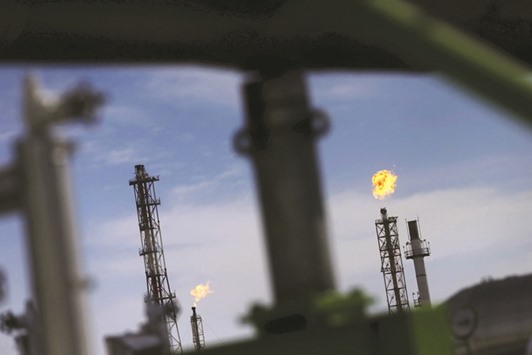The global oil market will be almost balanced next year as demand continues to rise faster than production, while the current oversupply is much smaller than previously thought, the International Energy Agency said.
The surplus in the first half of this year is about 40% smaller than estimated a month ago, as consumption proves stronger than expected while disruptions reduce supply, the Paris-based agency said. Still, the “enormous inventory overhang” that accumulated during years of oversupply will limit any significant increase in prices, it said.
“At halfway in 2016 the oil market looks to be balancing,” said the agency, which advises 29 nations on energy policy. “Less oil has been stockpiled than we originally expected” as “oil demand growth has been significantly stronger” and “unexpected supply cuts” strained the availability of crude.
Oil prices in New York have surged about 80% from a 12-year low in February to trade near $48 a barrel as production retreats amid investment cuts, wildfires disrupt operations in Canada and militant attacks hit exports from Nigeria. Prices tumbled last year as Opec refused to concede market share to a crude surplus triggered by years of booming shale oil output from the US.
Supplies outpaced consumption by 800,000 bpd in the first half of this year, the agency said, having estimated that difference at 1.3mn a day in last month’s report. In the second half, the market will be balanced as a drop in inventories in the third quarter counters another increase in the fourth. The rebalancing of the market may be delayed if halted supplies in Canada, Nigeria and Libya are able to restart, the IEA said.
“Overall, this is another bullish IEA report” that points to “clear light at the end of the tunnel and oil prices well above current levels,” Oswald Clint, a London-based analyst at Sanford C Bernstein, said in a report.
In its first published estimates for supply and demand for 2017, the IEA estimated that global oil demand will increase by 1.3mn bpd next year, the same rate as this year, to reach 97.4mn bpd.
Production outside the Organisation of Petroleum Exporting Countries will grow by a “modest” 200,000 bpd, with gains limited to Canada and Brazil. While US shale oil production will start to recover by the middle of next year, average output for 2017 will be 190,000 bpd lower, after falling 500,000 a day in 2016. Global inventories will decline by 100,000 bpd through the year, the IEA said.
As growth in demand exceeds non-Opec supply, more crude will be required from Opec. The organisation will need to provide an average of 33.5mn bpd next year, about 900,000 a day more than the 32.6mn a day its 13 members pumped in May, according to the report.
For 2016, the agency raised forecasts for global oil demand by 100,000 bpd on stronger US fuel use, and cut projections for non-Opec supply by the same amount.
Rising prices encourage shale producers
The oil market just hit a yellow light.
Crude’s advance of more than 90% from a 12-year low earlier this year has US shale producers starting to return to their drilling rigs, threatening to slow further gains, Bloomberg reported.
“The $50-to-$60 a barrel area is the sweet spot,” said Mark Watkins, the Park City, Utah-based regional investment manager for The Private Client Group of US Bank, which oversees $128bn of assets. “You start to have producers come back at $50, but a lot of them come in at $60.”
Money managers were cautious in the week ended June 7, betting more heavily on a price drop than on further gains, according to data from the Commodity Futures Trading Commission. West Texas Intermediate rose 2.6% to $50.36 a barrel on the New York Mercantile Exchange during the report week.
Prices have climbed enough for Continental Resources Inc to dispatch fracking crews to unfinished wells in the Bakken shale region, chief executive officer Harold Hamm said on June 9. Those wells were left uncompleted as tumbling prices forced explorers to halt projects to conserve shrinking cash flows.

A view of Mexico’s national oil company Pemex’s refinery in Salamanca, in Guanajuato state, Mexico. The oil surplus in the first half of this year is about 40% smaller than estimated a month ago, as consumption proves stronger than expected while disruptions reduce supply, the IEA said.


